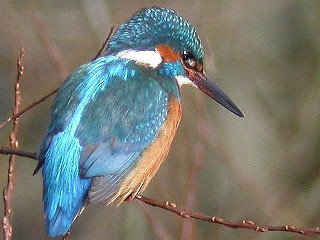 |
 |
| Photo: Ian Forrest | Photo: Ian Forrest |
For many of us the Kingfisher is usually seen as an electric blue streak as it flashes by close to the surface of a stream or river. I've been watching Kingfishers for almost eleven years at Conder Green, a coastal area on the River Lune estuary in Lancashire, and can truthfully claim to have seen the bird more times perched than in flight over the years. This location is also the most reliable place to see this bird I know of within our area, having assembled in excess of 110 records over the years of one of our most exotic creatures.
During this time an interesting fact has emerged. I only ever see a Kingfisher here during the months of July-November; in other words I never see a bird after a given date in November, until July of the following year, despite regular visits to Conder Green all year round. If this is sheer coincidence, then it is a rather big one, otherwise where does the Kingfisher actually disappear to during this seven-month period?
The Kingfisher we see in Britain (Alcedo atthis) is one of the most northerly members of a mainly tropical family; most of its relatives are confined to remote islands, mainly in the Pacific. In world terms the Kingfisher can be found from Europe eastwards across Asia and southeast Asia to New Guinea and the Solomon Islands. There are six different races of the Kingfisher in the world, but race ispida occupies much of Europe from Ireland and southern Scandinavia east to the Urals and the Caspian. Birds from northern and central Europe may make long migrations in search of a milder environment in which to spend the cold winter months.
They need clear, ice-free waters that are rich in small fish prey. This particular aspect of the birds habitat requirements actually makes the Conder Green birds - and their absence during the noted period - an even bigger mystery, simply because these birds have an all-year-round ice-free environment along the small, fast-flowing River Conder.
 |
 |
| Photo: Paul Burrows | Photo: Adrian Andruchiw |
Another interesting fact about the Kingfisher is that the mortality rate is quite high in harsh winter weather, but with breeding birds able to rear two broods - sometimes three - each of which has the potential to succeed with six young, rapid recovery is likely when you realise eighteen eggs are a possibility each year - though such successes are probably not common.
More interesting facts, this time relating to young birds which disperse from their natal territory soon after independence. Within weeks, even as early as July, birds may reach remote places like the Isles of Scilly, and records from Cape Clear Island are not unknown. A small number of individuals ringed in Britain in the breeding season have been recovered on the Continent, with one exceptional record of an immature bird ringed in Wales and caught on the north coast of Spain 19 days later (The Migration Atlas).
The Kingfisher is a highly vulnerable species; its breeding requirements are such that pollution and disturbance are a threat, and this, along with drainage and drought, all pose problems for the bird. Hopefully the day will never dawn when these threats have become so acute that we never again see the delights of the blue electric flash as it flies by on the stream.
 |
 |
| Photo: David H Hatton | Photo: Ken Plows |


